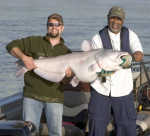- Missouri campgrounds resurgence (5/30/20)
- August a fantastic month for catfishing (8/11/18)
- Kayaking, canoeing good way to spend hot summer days (7/27/18)
- Hot weather means hot catfishing (7/7/18)
- Boat buyers have abundant options (6/16/18)
- Warm weather invites camping (6/9/18)
- Topwater fishing is a blast (6/2/18)
'Tis the season to snag a Missouri catfish
Saturday, July 11, 2015

Submitted photo/
This 80-pound blue catfish was caught on the Missouri River, near the confluence with the Mississippi River. Holding the fish is Kevin Krause (left) and Carl Roberts.
Nevada Daily Mail
The catfish family can be separated by a simple criteria into two major groups that anglers try to catch: the large catfishes that include channel cats, flathead and blue catfish, all of which often weigh over 20 pounds; and the bullheads both yellow and brown, which rarely exceed four pounds.
The recent statewide fishing report showed that fishing for catfish is good. With all the high water around and more rain in the forecast, catfish anglers are finding success. Carl Roberts and Kevin Krause hit the Missouri River near the confluence with the Mississippi River where Krause hooked an 80 pound blue cat assisted by Roberts.

Submitted photo/
Some of the boats in the Fourth of the July water parade.
Summer is catfish time. Another catfish angler who started young is Dennis Hymer of Strafford.
He said, "I went on my first catfishing trip when I was 5. It was at Riverton, Kan., then started fishing Grand Lake because they had Mississippi white cats. My dad was a catfisherman who liked to fish the falls near Joplin.
"We would walk out on the falls and fish straight down below the falls, and at night my cousin and I would set trot lines below the falls. We went after flatheads so we seined our bait from minnows to crawfish because the flatheads usually go after live bait. My largest cat I have caught on rod-and-reel was a blue cat that weighed 22 pounds."
Catfish are also good fighters on rod-and-reel. Hymer said, "When you hook a cat that weighs 4 or 5 pounds, you have a good battle on your hands. Not only are they good fighters, they make good table fare. I think catfish, if cleaned properly, are as good or better than crappie. You have to clean them up and get rid of the dark meat.
"I have noticed that the cats move a lot and like crappie, they move in and out in a lake. The other day I had two lines out and had a fish on both rods at the same time. Then, nothing happened for a while, but maybe a couple hours later they move in again and I caught a couple more before they moved out."
Catfish angler Jack Nelson of Jefferson City, whose first fish was a bullhead cat, recalled how he used to bring home a lot of bullheads and yellow cats from a small stream when he was growing up.
He said, "I couldn't wait until school was out for the summer so I could go catfishing. Several of my buddies would dig a can of worms and head for the stream where we knew we could catch catfish. You never forget those times."
Many anglers have a nostalgic feeling about bullheads because its likely that a bullhead was their first catch, and has served as a catalyst that sparked an interest in other types of fishing.
Although the tackle and techniques for catching bullheads is simple ---- anglers of today can increase their catch with some adjustments in methods and the purchase of inexpensive, but more efficient tackle.
Everything from cane poles to spoonbill rods have been used to catch bullheads, but one of the best outfits is a lightweight spinning rod-and-reel then you can cast farther and feel the bite and set the hook. A six pound monofilament line is about right for casting bait and is easy to detect bites.
Nelson once told me he grew up fishing for bullheads at a stream close to his home. He said, "I have learned a lot about catching bullheads. You don't need a big heavy sinker or large hooks. Use a small split-shot sinker to keep the bait above the muck on the bottom of the lake or stream you are fishing. The hook size is an important part of your tackle. Long-shanked hooks are best because most bullheads swallow the hook, so long.shanked hooks are easier to retrieve.
"I always fish without a bobber because a bobber will keep the bait off the bottom and bullheads are bottom feeders. For bait, I usually just get some nightcrawlers."
In summer, bullheads move into deeper waters of lakes. That is why boat anglers outfish bank anglers. During July and August night fishing is almost a must when fishing the warm waters in lakes and ponds.
The honor of being named Missouri's state fish belongs to the channel catfish. They are found in nearly all of our lakes, ponds, streams and rivers.
Catfish are omnivorous feeders with a well developed sense of smell, which means the fish is most often attracted to smelly morsels of food. Smaller catfish feed primarily on bottom-dwelling organisms, but as they grow larger, their diet changes to a wider variety of food items. Fish, either alive or dead, make up the bulk of their diet. Flathead cats prefer live bait while channel cats feed on whatever is available.
Jim Franklin of Harrisonville, is a dyed-in-the-wool channel cat angler who enjoys the beauty of a stream, but isn't fooled by the tendency of a stream to hide catfish.
He said, "My experience over the years has shown that catfish aren't evenly dispersed over a stream bottom, they are concentrated in certain areas.
"An anglers success in putting fish on a stringer depends on their ability to find those areas that hold fish. That old saying goes that 90 percent of the fish are concentrated in 10 percent of the habitat. To improve your chances on catching catfish, observe locations that produce fish-or likewise areas that don't produce fish.
"To be a successful cat fisherman, check the riffle just above pools, cut-banks, snags and other submerged structures that are in the stream."
Lakes also produce good channel catfish fishing. In fact, usually the largest catfish caught in the state each year was caught in a lake or pond. Catfish caught in man-made lakes that weigh 10 pounds or more are common.
Catfish, like all fish, are not randomly distributed, but are congregated in particular locations. Fishing success will depend on your ability to find these concentrations of fish.
Some tips on fishing for catfish include;
* Catfish can be caught year round.
* Use prepared cheese baits in the summer when the water temperature is above 70 degrees.
* Cheese bait are most effective on fish in the 10 to 16 inch range.
* Live bait is best for larger fish, those above 3 pounds.
* Use dead minnows or cut-bait when the water temperature is below 60 degrees.

